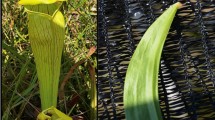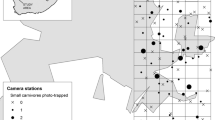Summary
A field study of two carnivorous plant species, Drosera intermedia and D. rotundifolia, was carried out in a small silting-up bog in Southern Bavaria (FR Germany). Various parameters of undisturbed individuals of both species were measured for a period of two years and subjected to a partial correlation analysis. The importance of prey as a limiting factor for various fitness parameters was confirmed for both species. Other factors may occasionally also be limiting, e.g. assimilation area and water supply. Benefits obtained from the prey are partly transferred to the next year via the winter bud. The importance of the relative demonstrated: Plants of D. rotundifolia showed higher fitness values in higher positions, those of D. intermedia in lower positions. Growth characteristics of both species tended to influence the height of their own position in a corresponding direction: D. intermedia downwards and D. rotundifolia upwards. In both species negative effects of intraspecific neighbourhood were evident, whereas interspecific effects were not detectable. Plants of D. intermedia tend to influence their neighbourhood situation by changing their position by rhizome-like stem growth. In D. intermedia the decision to reproduce by seeds or axillary buds seems to be made at least partially already in the year before. D. rotundifolia was only observed reproducing by seeds. In spite of different catching characteristics (plant shape, plant size, microhabitats, prey spectra), the general catching success, measured as prey biomass per plant biomass, was equal in both species of sundew. This agrees with earlier findings that in this bog both species have the same biomass per ground area.
Similar content being viewed by others
References
Büsgen M (1883) Die Bedeutung des Insektenfangs für Drosera rotundifolia. Bot Z 41:569–577 585–594
Chandler GE, Anderson JW (1975) Studies on the nutrition and growth of Drosera species with reference to the carnivorous habit. New Phyt 75:129–141
Darwin C (1875) Insectivorous plants. Murray, London
Darwin F (1878) Experiments on the nutrition of Drosera rotundifolia. J Linn Soc Bot 17:17–23
Ellenberg H (1974) Zeigerwerte der Gefäßpflanzen Mitteleuropas. Scripta Geobotanica IX/9:5–97
Harder R (1964) Vegetative Entwicklung und Blütenbildung in axenischen Kulturen der Insectivore Drosera pygmaea. Planta 63:316–325
Hegi G (1935) Illustrierte Flora von Mitteleuropa. Lehmanns, München
Jackson DI, Sweet GB (1972) Flower initiation in temperature woody plants. Hortic Abstr 42:9–24
Kellermann Ch, Raumer E (1878) Vegetationsversuche an Drosera rotundifolia, mit und ohne Fleischfütterung. Bot Z 36:209–218 225–229
Lloyd FE (1942) The carnivorous plants. Chronica botanica, Waltham Mass, USA
Lüttge U (1983) Encyclopedia of Plant Physiology, Physiological Plant Ecology III, New Series, Vol 12C
Paul A, Lutz J (1941) Zur soziologisch-ökologischen Charakterisierung von Zwischenmooren. Ber Bayr Bot Ges 25:1–28
Thum M (1986) Segregation of habitat and prey in two sympatric carnivorous plant species, Drosera rotundifolia and Drosera intermedia. Oecologia 70:601–605
Thum M (1988) The significance of carnivory for the fitness of Drosera in its natural habitat: 1. The reaction of Drosera intermedia and D. rotundifolia to supplementary feeding. Oecologia 75:472–480
Thum M (1989) The significance of opportunistic predators for the sympatric carnivorous plant species Drosera intermedia and Drosera rotundifolia. Oecologia 81:397–400
Tutin TG (1968) Flora europaea. University Press, Cambridge
Wilmanns O (1978) Ökologische Pflanzensoziologie. Quelle & Meyer, Heidelberg
Author information
Authors and Affiliations
Rights and permissions
About this article
Cite this article
Thum, M. The significance of carnivory for the fitness of Drosera in its natural habitat. Oecologia 81, 401–411 (1989). https://doi.org/10.1007/BF00377091
Received:
Accepted:
Issue Date:
DOI: https://doi.org/10.1007/BF00377091




